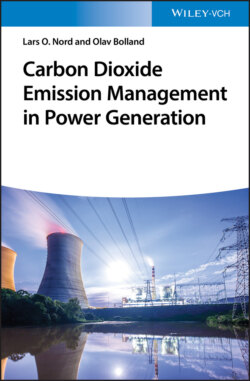Читать книгу Carbon Dioxide Emission Management in Power Generation - Prof. Lars O. Nord - Страница 18
1.4 Man-made Emissions of CO2
ОглавлениеHuman activities result in emissions of mainly four greenhouse gases: carbon dioxide (CO2), methane (CH4), nitrous oxide (N2O), and the halocarbons (a group of gases containing fluorine, chlorine, and bromine). These gases accumulate in the atmosphere, causing concentrations to increase with time. Significant increases in all of these gases have occurred in the industrial era.
The emission of CO2 and other greenhouse gases does not only depend on technology but also depend on other mechanisms in society. The emission of CO2 is closely linked to energy conversion, and one can depict the relation between the emission, the energy consumption, Gross Domestic Product (GDP), and population, as in Eq. (1.2), which is a slightly modified version of that presented originally by Kaya et al. (1989). This equation is a simplified way of expressing the relation between these parameters, but it provides a good qualitative illustration of how CO2 emissions are related to these parameters. One obvious flaw in this equation is that the highest increase in population comes in areas where the GDP and energy consumption per capita is below the world average, and consequently, the equation overestimates contribution from the population factor.
(1.2)
1 This ratio expresses the CO2 formation related to energy consumption in society. The value of this ratio is closely related to the technology being used in terms of efficiency. The type of fuel (coal, oil, natural gas, and biomass) is also important for this ratio, which is further discussed in Section 4.2. The switch from coal to natural gas reduces the value, as do efficiency improvements. In some areas of the world, the dependence on coal is stronger than in others, where natural gas may be more accessible. The potential for reducing this ratio mainly depends on fuel availability and fuel selection and to some extent on how far efficiency is pushed when new power plants are built. There is still a huge potential for improving efficiency in power plants and other processing industries.
2 This ratio is the energy intensity, which is calculated as units of energy per unit of GDP. The ratio says something about the structure of industry, transportation systems, and agriculture. An agricultural country would typically have low energy intensity, whereas, on the other hand, a country with a lot of metal production will typically have high energy intensity. In general, one can say that a high refinement ratio in the industry increases the energy intensity. One should here be aware that the international trade in products and raw materials that require a lot of energy (e.g. aluminium) is large. It may be that a country that is consuming a lot of energy-demanding products is importing most of them. In such a case, the energy intensity does not express the real energy intensity caused by the activities in that country. One example is cars, which are produced only in a few countries. Another example is production of heavy oil or bitumen, like in Venezuela and Canada, where much energy is spent on producing oil that is mainly exported.
3 GDP of a country is defined as the market value of all final goods and services produced within a country in a given period of time. It is also considered the sum of value added at every stage of the production of all final goods and services produced within a country in a given period of time. One can consider the GDP as a measure of standard of living, which means consumption of goods, travel, heating, etc.
4 According to Eq. (1.2), the population contributes proportionally to the emission of CO2. The annual world population growth was about 83 million in 2017, which is about a 1.1% growth rate.
It is indeed a challenge to balance the population growth with technology improvements (term 1) and energy intensity reductions (term 2) with respect to CO2 emissions.
